

The Navy has to figure out how to harness, organize and deliver its data to users before it can start utilizing that data for decision making.
The Navy is considering how best to go about architecting its future systems to take advantage of the massive amounts of data it’s been collecting since the 1960s. But first, it’s got to figure out how to organize and harness that data first. That’s why it’s looking into creating a new chief data officer position to do just that.
Near-peer adversaries like China and Russia have a headstart. They’re already working on distilling the data they collect into its most potent form. And Federal News Radio’s Scott Maucione said on Cybersecurity month that trying to filter through all that to identify what pieces of data are relevant to any given situation can be like searching for a needle in a pile of needles.
But the key to competing with China and Russia militarily is being able to reach better decisions, faster. Deputy Chief of Naval Operations for Information Warfare Vice Adm. Jan Tighe discussed just how the Navy is trying to improve those capabilities at AFCEA’s Navy IT day.
“It starts at the beginning with the data,” Tighe said. “The data we collect with our [Intelligence, Surveillance and Reconnaissance] sensors, the data that we collect about our people, the data we collect about our financial systems, the data we collect off of actual hardware in terms of the performance of that hardware. That data has been collected in various forms with various degrees of accuracy for many many years. That data has also been spread around to various types of data centers around the country and other places that the Navy owns and operates.”
Tighe said the Navy has been working to consolidate data centers for the past five years, and now it’s looking at moving into the cloud.
“Part of that calculus requires a data strategy that makes sense of the data that we’re moving to the cloud, which data needs to go to which kinds of clouds,” she said. “Which data needs to be organized together, what are the standards by which we’re collecting that data.”
This goes back to Maucione’s needle analogy — the best way to begin finding a needle in a pile of needles is to sort them by type. Tighe said that sometimes, two different types of data can look similar, but tell contrasting stories.
Toward that end, Tighe said the Navy is working to revitalize its functional area managers to begin sorting through that data and determining what is useful, and what is just chaff. Once they’ve determined what kind of data is needed to fulfill specific functions, the Navy can begin architecting its systems to support those functions.
Tighe said these kinds of advancements in data application can lead to better analytics for logistics, pursuit of machine learning and human-machine teaming, even AI. All of these things would help the Navy make better decisions faster.
But Maucione said this is not yet the process to get to where the Navy wants; this is just preliminary work. In order to reach the Navy’s goals for data, it’s going to need a chief data officer, which is something the service is currently exploring.
Tighe said the Navy is working to figure out what data and services users are going to need, and how the Navy can provide them. That’s the key to taking the next step.
Copyright © 2025 Federal News Network. All rights reserved. This website is not intended for users located within the European Economic Area.
Daisy Thornton is Federal News Network’s digital managing editor. In addition to her editing responsibilities, she covers federal management, workforce and technology issues. She is also the commentary editor; email her your letters to the editor and pitches for contributed bylines.
Follow @dthorntonWFED

